Adventurers in the Rockies
Chapter Twenty-four
Leadville to Climax on the
Leadville, Colorado & Southern Railroad
July 23, 2016
Saturday
by
Robin Bowers
Text and Photos by Author
The
author retains all rights. No reproductions are allowed
without the author's consent
Comments are appreciated at...yr.mmxx@gmail.com
After breakfast in my motel
dining room, I walked next door to the Holiday Inn and waited
for our buses to load and leave. We will be be traveling west
out of Denver on I-70 through the mountains, mining locations
and winter sports recreation areas. Then after two hours and 103
miles we will exit at Minturn CO at exit 171. Then we will be
south bound on US 24 for 55 minutes and 30 miles, arriving at
Leadville.
Shortly after 9 AM we were
boarded and leaving the hotel in the Stapleton area.
About twenty minutes after leaving the city, we saw our first
look at open pit mining.
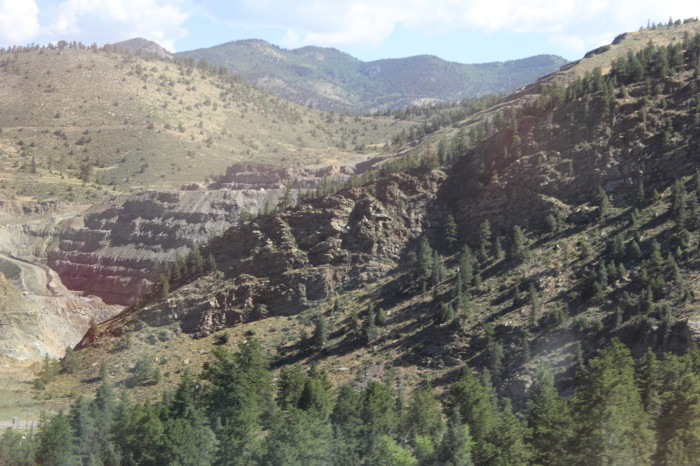
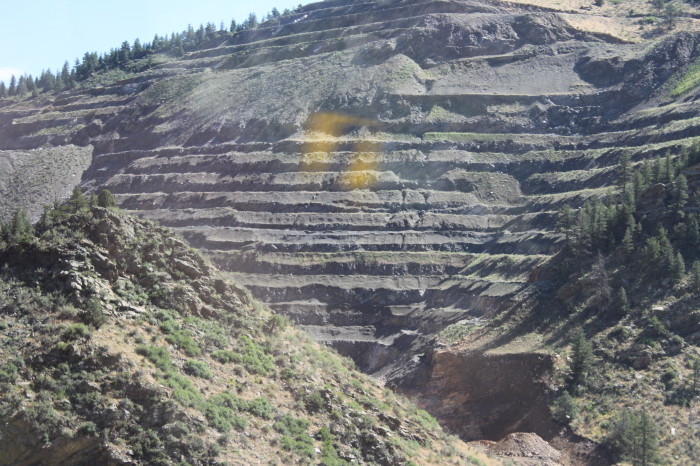

ARGO Gold Mine & Mill near Idaho Springs, CO.

A quick peek at Colorado and Southern Railroad loco 60 in the
downtown Idaho Springs business district.



i


Part of Dillon Reservoir's 25-mile shoreline.
East of Dillon on I-70, the
1.5 mile Eisenhower-Johnson Memorial Tunnel Complex burrows
through the heart of Mount Trelease. Besides being a milestone
in highway engineering, the tunnel bypasses US 6 and the
11,992-foot Loveland Pass, which is often hazardous in winter.




Residential housing in the Vail area.
The resort was founded in 1962 by members of the 10th Mountain
Division who trained near Vail at Camp Hale.




Traffic on I-70.

The first two of our buses exiting I-70 for south bound US 24.

The start of our southbound trip on US 24.

The DRG&W yard in Minturn.

A festival was happening in Minturn.
It was decided to take US 24 over Tennessee Pass as it is the
historic route of the Denver and Rio Grande Western Railroad.

Several times while on US 24, we saw groups of bicyclists riding
alone the road. The Leadville Trail 100 Bike race is held each
summer.




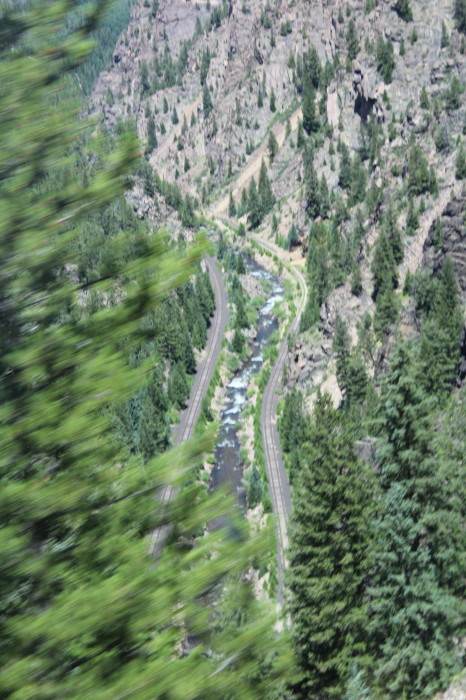
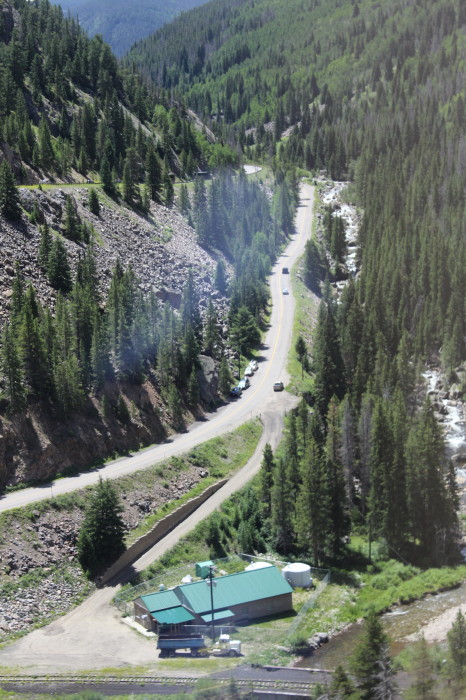

The bridge and railroad below at Red Cliff.
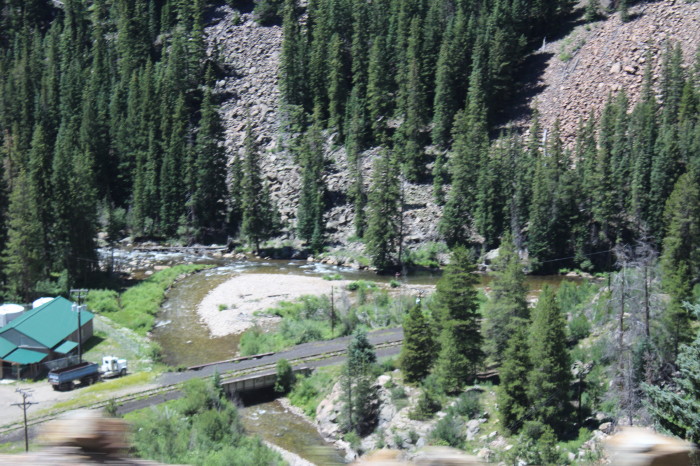

The railroad at Pando which once served Camp Hale. We will now
start to cross the Tennessee Pass.





Leadville
Leadville, Colorado & Southern Railroad
Originating in "the highest
incorporated city in North America," the LC&S takes
passengers along the old Denver, South Park & Pacific and
Colorado & Southern lines to the Continental Divide. But, as
the old adage states, "It's not the destination, but the journey
that's important." This journey is full of breath-taking
panoramas across the Arkansas River Valley and humorous
narratives about Leadville's colorful past. Mining and
railroading were a large part of the local history, and today's
passengers will find it easy to step back in time on the
Leadville, Colorado & Southern.
Adventure, relaxation and
sightseeing cannot be topped when riding in the Rocky Mountains
on board the Leadville Colorado & Southern Railroad. This
2.5 hour adventure through the untamed wilderness of the San
Isabel National Forest is not to be forgotten. Family and
friends of all ages have a chance to engage in learning about
the historic Leadville, Colorado home to legends like Molly
Brown and Horace, Augusta and Baby Doe Tabor, Guggenheim and at
one time Doc Holiday.
The Leadville Colorado &
Southern Railroad travels north along the Arkansas River Valley,
it raises up 1,000 feet off the valley floor so that you will
have some spectacular views of Fremont Pass and the two tallest
peaks in Colorado, Mt. Massive and Mt. Elbert.
Other highlights include a
chance to meet the engineer, take a tour of the caboose and
engine. If you come in July and August warm weather exceeds
expectations at 75 degrees, it is not surprising to find snow
through June and in late September. Although cool, the fall
colors are not to be missed with amazing displays of gold, red
and orange Aspen trees lighting up the mountain side. Bring a
picnic lunch and eat on the train if you wish, but be sure to
not forget your cameras and jackets.
History
The Colorado and Southern
Railway (reporting marks C&S, CS) was an American Class I
railroad in the western United States that operated
independently from 1898 to 1908, then as part of the Chicago,
Burlington and Quincy Railroad until it was absorbed into the
Burlington Northern Railroad in 1981.
The railway began as the
consolidation of bankrupt railroads on 1898. The Colorado
Central Railroad and Cheyenne and Northern Railway were brought
together to form the Union Pacific, Denver and Gulf Railway in
1890. When Union Pacific went bankrupt in 1893 they were
separated from the Union Pacific and united with the Denver,
Leadville and Gunnison Railway and others, by Frank Trumbull to
form the Colorado and Southern Railroad in 1898. In 1908 the
Chicago, Burlington and Quincy Railroad bought control of the
C&S. It would later merge into the Burlington Northern
Railroad in 1981.
At the end of 1970 it operated
692 miles of road on 1116 miles of track; that year it reported
1365 million ton-miles of revenue freight. In 1980 route-miles
had dropped to 678 but ton-miles had ballooned to 7230 million:
Powder River coal had arrived.
C&S was also the parent
company of the Fort Worth and Denver Railway, which ran from a
connection at Texline south and east into Texas. The FW&D
was established as a separate company because Texas law required
that railroads operating within its borders must be incorporated
within that state.
Narrow gauge
The Colorado and Southern
narrow gauge lines were formed in 1898 from the Colorado Central
and the Denver, South Park and Pacific Railroads. The narrow
gauge had four distinct lines: the Platte Canyon Line from
Denver, Colorado to Como, Colorado, the Gunnison Line from Como
to Gunnison, Colorado via Alpine Tunnel, Highline between Como
and Leadville, Colorado, and the Clear Creek line from Denver to
Silver Plume, Colorado. Major Branch lines were the Baldwin
branch between Gunnison and Baldwin; the Keystone from Dickey,
Colorado to Keystone, Colorado; the Blackhawk branch between
Forks Creek and Central City, Colorado; the Alma Branch from
Como to Alma, Colorado; and the Morrison Branch from Denver to
Morrison, Colorado. The Colorado and Southern narrow never owned
a new engine, all motive power coming from the former companies.
Downfall of the narrow gauge
In contrast to the preserved
D&RGW narrow gauge equipment and infrastructure, few traces
of the Colorado & Southern remain. Today there are five
surviving Locomotives: C&S 31 is at the Colorado Railroad
Museum painted as Denver Leadville and Gunnison 191, C&S 71
is on display in Central City, Colorado, C&S #9 is on
display in Breckenridge, Colorado, C&S 60 is on display in
Idaho Springs, Colorado, and C&S #74 is currently on display
at the Colorado Railroad Museam in Golden, Colorado. Two
roundhouses survive in Como, Colorado and Leadville, Colorado.
Rolling stock has been scattered across the US. Some are on
display in Colorado, One mail car found its way to Nebraska, and
some boxcars are on the White Pass and Yukon Railroad in Alaska.
Remaining Water towers are the French Gulch tank near Leadville,
Bakers tank near Breckenridge, and Halfway tank near Alpine
Tunnel. The Georgetown Loop was rebuilt in the 1980s and is
active in the summer months.
 The Leadville, Colorado & Southern Railroad
The Leadville, Colorado & Southern Railroad
The Leadville, Colorado and
Southern Railroad is another of Colorado's many tourist
railroads operating over lines that once sought the riches the
region had to offer, and just like the others operates through
the spectacular Rocky Mountain Range, departing each trip from
the historic mining town of Leadville at the former Colorado
& Southern restored depot. The LC&S operates on trackage
that was once part of the Colorado & Southern's vast
narrow-gauge lines in the area and while it is the only tourist
railroad not to offer steam locomotives powering its trains it
does offer very reasonable prices for its trips (which is one
reason folks continue to return). So, if you are in the area
vacationing or visiting nearby Denver considering swinging by to
see this railroad, which provides unparalleled views of the
Rocky Mountains.
The Leadville, Colorado and
Southern Railroad has its beginnings dating back to 1980 when
the Burlington Northern, successor to C&S parent Chicago,
Burlington & Quincy sold off its depot, branch line, and all
local rolling stock around Leadville, which was purchased by
interests that would go on to form the LC&S. The earliest
history of C&S's silver mining branches dated back to the
Colorado & Clear Creek Railroad chartered in 1865 (later
renamed the Colorado Central Railway). At the time the region
was becoming a major producer of silver (and to a lesser extent,
gold) and the Union Pacific, which originally owned these mining
branches, looked to exploit it. The Colorado Central later
incorporated the Georgetown, Breckenridge & Leadville
Railway to continue marching southwest in an attempt to reach
additional mines and the towns they created.
By 1898 the Colorado &
Southern Railway was created to takeover bankrupt properties
operated by Union Pacific, which included all of its mining
branches. By this time the lines were operated primarily by two
companies the Denver, South Park & Pacific Railway and the
Denver, Leadville & Gunnison Railway (which the LC&S now
operates). Unfortunately, the properties were no longer as
profitable as they had once been due to the passage of the
Sherman Act in 1890 that looked to regulate the silver mining
industry (there was too much being produced). While the C&S
worked to standard gauge much of these mining branches, by the
1940s most had been abandoned or sold.
Today, when riding the
Leadville, Colorado and Southern Railroad it operates on a route
that rises over 1,000 feet from the Arkansas River Valley,
travels through Fremont Pass and provides for views of
Colorado's two largest mountain peaks, Mt. Massive and Mt.
Elbert. Overall the line operates through the San Isabel
National Forest and lasts for more than 2 hours covering about
21 miles round-trip. Aside from the Georgetown Loop Railroad, it
is the last remaining section of the Colorado & Southern's
mining branches still in operation.
For power the LC&S uses a
single Electro-Motive Division Geep diesel locomotive with
trains departing the restored Leadville depot (a D&RGW
freight depot also remains in the town). If the organization
could ever resurrect or purchase a steam locomotive to run on
the property they could likely draw in even more visitors.
Despite this, however, it is still an excellent attraction and
worth the visit. Also, if you the time and chance check out the
other similar excursions in the region such as the Georgetown
Loop, Durango & Silverton, and/or Cumbres & Toltec
Scenic. Currently, the LC&S operates a schedule that runs
between late May and early October. They also offer extras such
as riding in the locomotive and caboose (for a small additional
fee), as well as special events throughout the year including
photo ops, wildflower trains, a rare night ride, and river
rafting packages.

Colorado Southern 2-8-0 641 last run on September 12, 1962
before it was put on display near the Leadville station. 78 1/2
years of steam on the high line came to the end.

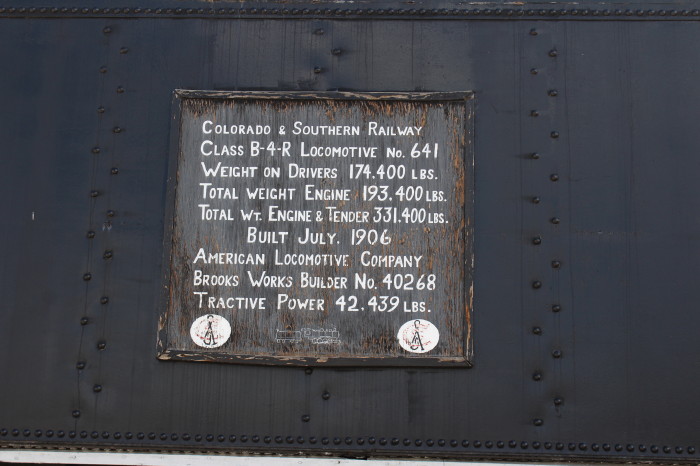

Leadville, Colorado and Southern Railroad GP-9 1918.
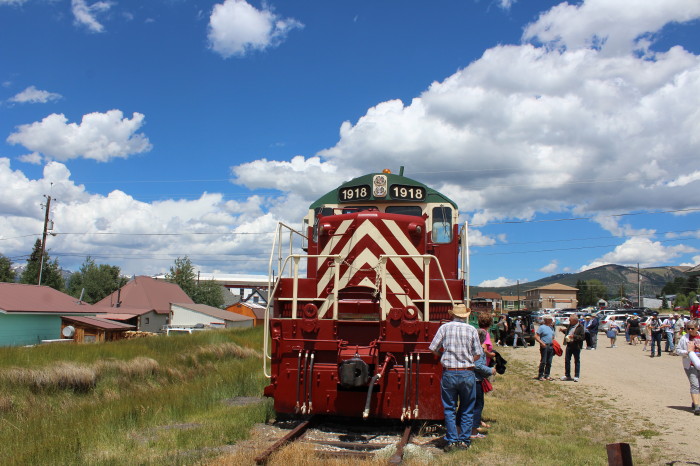


MP 151.2 Leadville, Colorado & Southern Railroad Depot.
The red brick depot, located
at the corner of 7th and Hazel Streets, was completed in January
1893 during the Union Pacific Railroad (UP) ownership of the
Denver, South Park & Pacific Railroad. It replaced a
small frame passenger built soon after the DSP&P reached the
Leadville in September 1884. The ground elevation at the depot
is 10,208 ft.
The numbers on the mileposts
indicate the distance by rail from Denver, where the Denver,
South Park & Pacific Railroad started. Thus the
Leadville depot is 151.2 miles by rail from Denver.
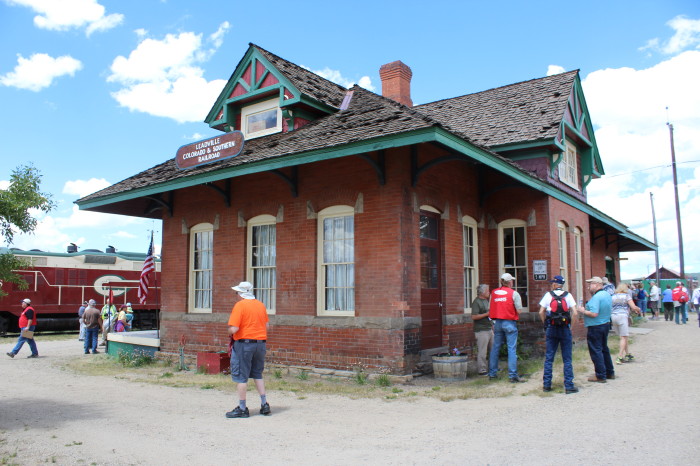


Leadville, Colorado and
Southern Railroad GP-9 1918. The consist was LCS GP-9 1918, LCS
1001 open air car, LCS 1002 covered open air car, LCS 1003
concession. LCS 1005 open air car, LCS 1006 covered open air
car, LCS 1007 covered open air car and LCS 1008 caboose.

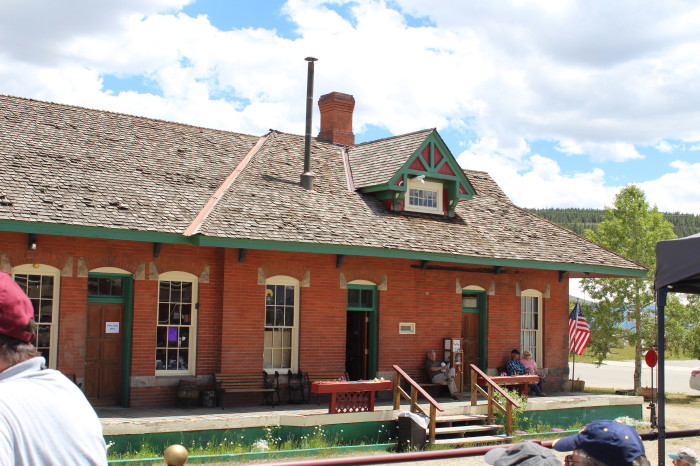


Mt. Elbert, el. 14,433 ft., the highest peak in Colorado.

Leadville neighborhood.


MP 151.0 North side of 11th Street.
The abandoned three-story red brick building in the west is St
Vincent's hospital. This second St. Vincent's was built in 1901 by
the Sisters of Charity to replace their first hospital built in
1879. This building was used until 1954; a new St Vincent's opened
in 1958.

Miners were frequently hurt
or killed in falls, fires, rockfalls, cave-ins and explosions
during blasting. They were also prone to respiratory problems
because of poor ventilation in the mines and the huge quantities
of rock dust from the primitive drills ("widow makers") that did
not use water to keep the dust down. Pneumonia and "miner's
consumption" were common cause of death in the early years
before any sort of worker protection. St Vincent's and other
early hospitals were very important to all citizens of
Leadville.

MP 150.6 Spur track to LC&S Roundhouse on left.
The roundhouse was originally an eight-stall building, covered
with sheet-iron. By 1936 two stalls had been removed. After narrow
gauge operations ceased in 1943, three more stalls were removed
and the doors were enlarged to handle the larger standard gauge
steam engines. The turntable was also removed at that time. After
steam operations ceased in September 1962, the 50,000-gallon water
tank was removed.

LCS GP-9 1714.


The caboose is on point and leading.






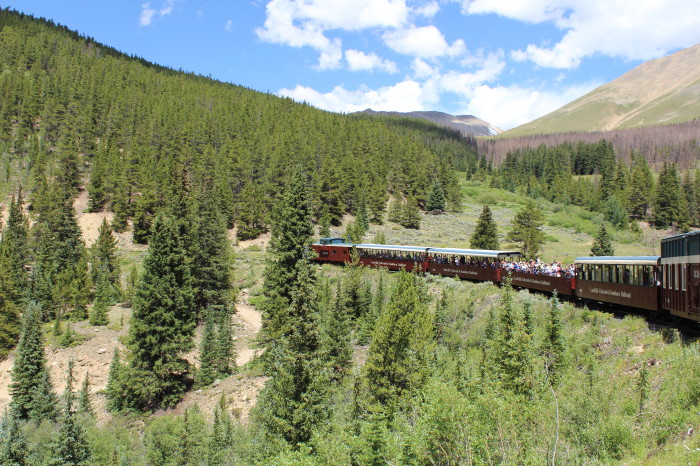

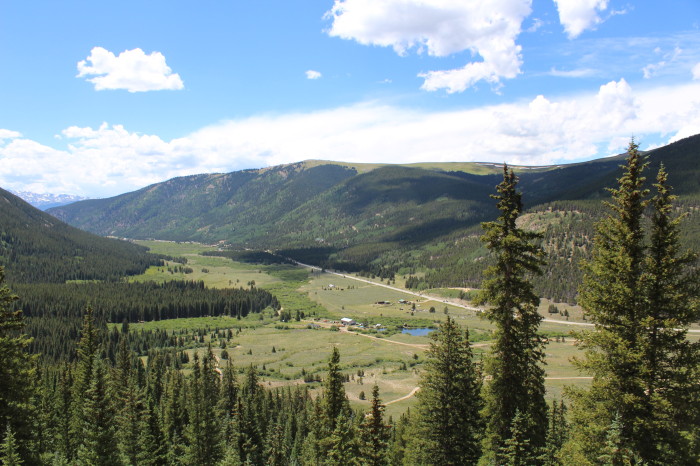
Looking south on US 24.

Looking north on US 24.

Equipment for zip line rides.

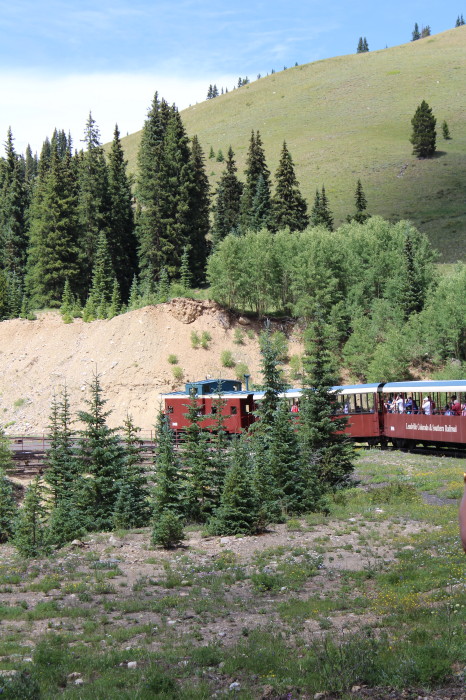


MP 142.3 French Gulch Water Tank elev 10840 ft. cap
47,500 gal.



View of Climax Molybdenum Mine and East Fork Arkansas River.

Above, MP 138.06 Wortman Mine el. 11,240 ft.
A four car-spur connected with the Wortman mine, started by G.C.
Wortman, whose mine was near the John Reed mine. Some high-grade
ore was produced, but the mine closed in the late 1880s. A Post
Office served the area from Sept 25, 1900 to Aug. 31, 1908 and
again from May 25, 1916 to Jan 15, 1919.
Out of track, End of the line.
MP 137.46 Climax, at Summit of Fremont Pass el. 11,318ft.
Even though the D&RG
crossed Fremont Pass in 1880, no station or facilities were
built at the summit until mining started at the Climax mine. In
1884, when the DSP&P finally reached the top of Fremont
Pass, they built a covered turntable and other facilities and
named the station Climax. Rails of the two companies were the
minimum distance apart, and yet there was no interchange track!
After all, these two railroads were in fierce competition with
each other.
Fremont Pass was named for explorer Lt. John
C. Fremont, who wandered through much of Colorado on several
expeditions searching for a suitable railroad route across the
Continental Divide. Even though both the D&RG and DSP&P
finally conquered Fremont Pass, Lt. Fremont never crossed it.
Water in the Arkansas River eventually
reaches the Mississippi River and flows int the Gulf of Mexico,
whereas water on the eastern side of the divide in Tenmile Creek
flows into the Colorado River on its long journey to the Pacific
Ocean.
The train has reached our farthest point
from Leadville, only fourth time that a train has traveled this
far on the railroad since 1984. After a short rest we began our
return trip to Leadville and on the way back we will stop at the
water tower for our photo run by. We are also 1,110 feet above
the Leadville Depot. It's all down hill from here.


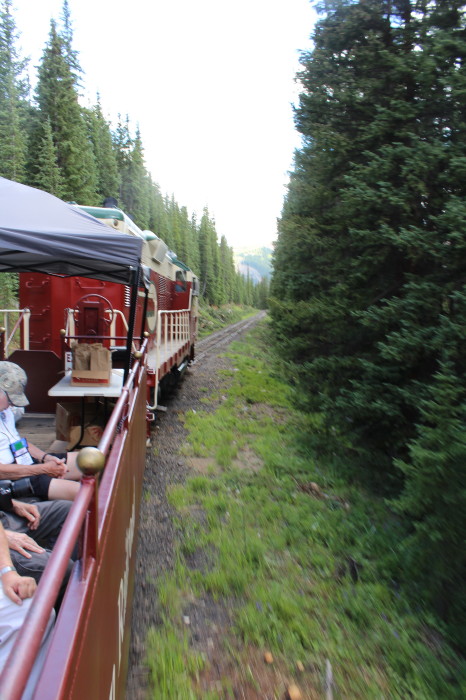
Riding through Spruce Forest.



Much timber was cut on the hillsides of this area. A view down the
valley in which the Arkansas River meanders back and forth.



At the water tower our train
stopped and the photographers who wanted to climb the hill to
take photos of our train as it travels by were allowed leave the
train at this time. I decided to remain on the train for this
run by as I wasn't wearing my mountain hiking boots and I wanted
to see the view from this point of view.
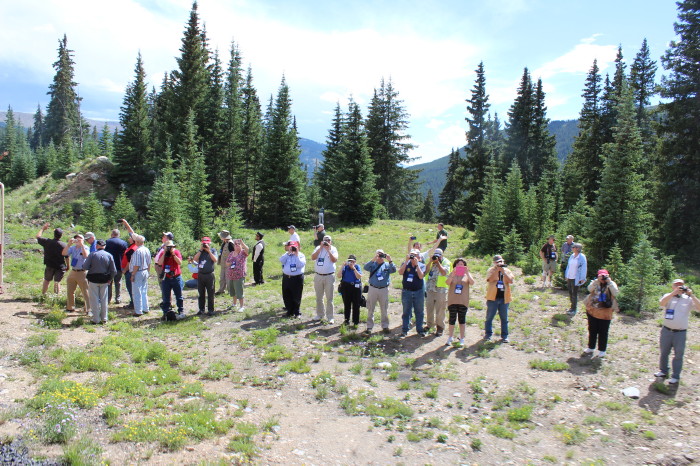
Hill climbing conventioneers taking photos as we pass by.
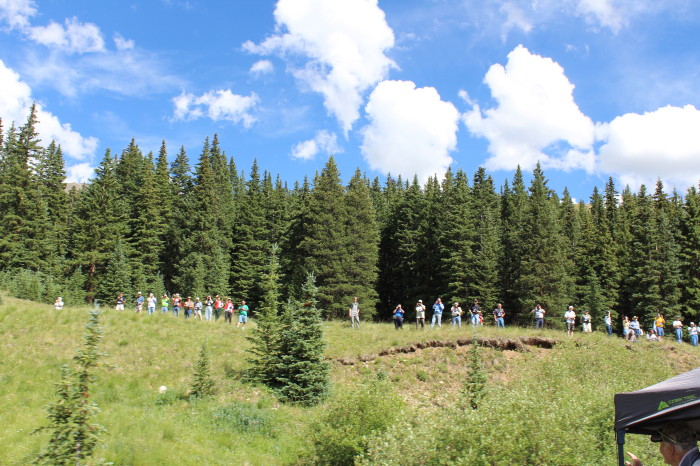
And more on the next hill.

Hill people returning to the train.

MP 142.3 French Gulch Water Tank.
The vegetation here is
different from that found around Leadville and is typical of
that found in the upper sub-alpine life zone. Summer wildflowers
include yellow alpine paintbrushes, sulfur flowers, black-tipped
senecios, golden asters avens, several species of buckwheat,
little red elephants, kings crowns, rose crowns, lavender
lupines, harebells, purple fringes, columbines any tiny
fleabanes.
The 47,500-gallon wooden tank has had an
interesting history. The tank originally stood on the opposite
side of the track but in 1943 when the High Line was converted
to standard gauge, it was moved and raised so the spout would
fit over the taller standard gauge engine tenders. Water for the
tank came from a small reservoir on the hill above the track.


Happy and excited riders on the zip line.
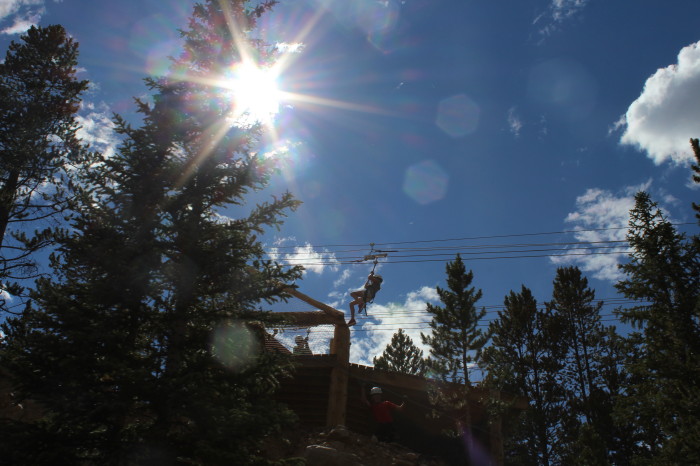


Looking south on US 24.

Old St. Vincent's hospital.
Past St. Vincent's it was
just a short hop to the Leadville, Colorado & Southern
Railroad Depot. After arriving, the conventioneers left the
train and then boarded their buses. We left around 5:45pm via a
different route to I-70. Route US 91 would be shorter to I-70
than going back on US 24. Minutes after leaving Leadville, US 91
was close to the mine buildings for us to get a good look.

Buildings part of the world's largest molybdenum mine.


Our return took us through the I-70, 1.5 mile Eisenhower-Johnson
Memorial Tunnel Complex with several rain showers along the way.
Forecast for tonight is for intermittent rain.
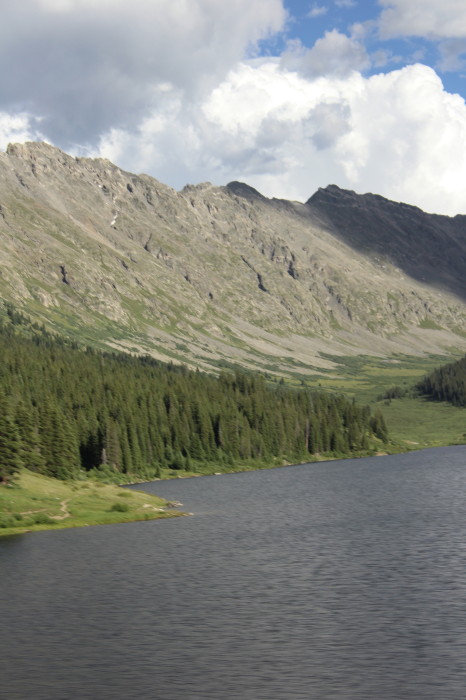
Dillon Reservoir next to I-70.


Georgetown Loop Railroad's Silver Plume area.
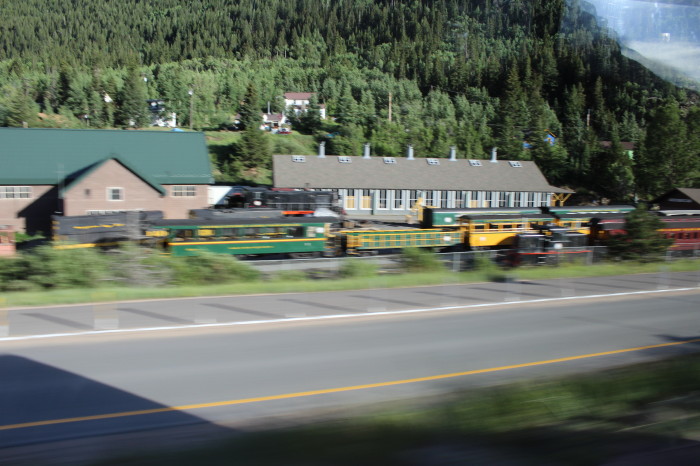

One last mine site before entering the city.

Denver skyline.

A rainbow ending over our hotel.
After leaving the bus at the Holiday Inn I walked over to my motel
room and began packing to leave in the morning as this would be my
last night in Denver and Colorado. The 2016 NRHS convention has
come to a end. Tomorrow Chris and I will be heading west and on to
familiar pastures. Tomorrow night will find my head resting
somewhere in the wilds of New Mexico.
Thanks
for reading.
Text and Photos by Author
The
author retains all rights. No reproductions are allowed
without the author's consent.
Comments
appreciated at .... yr.mmxx@gmail.com
